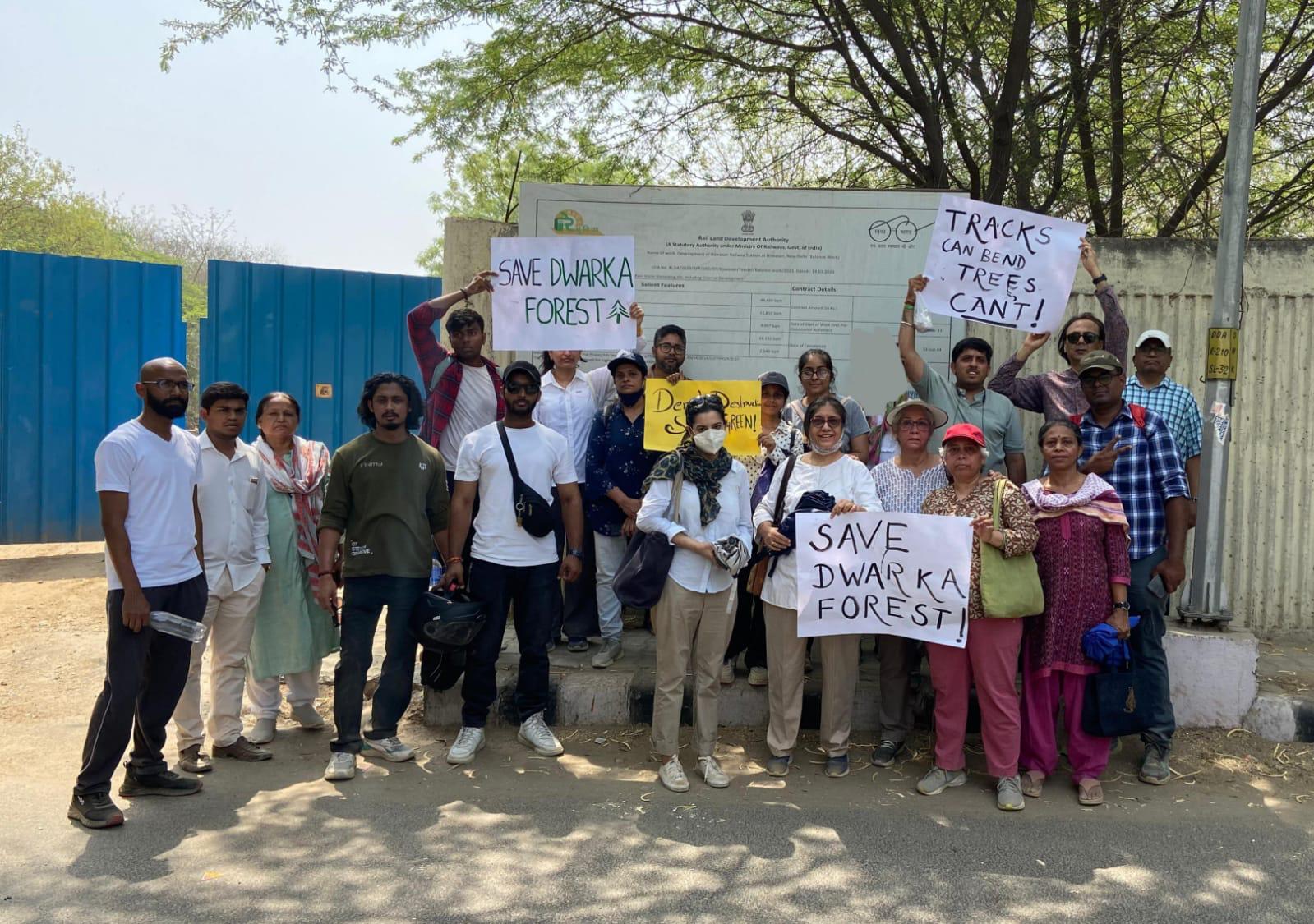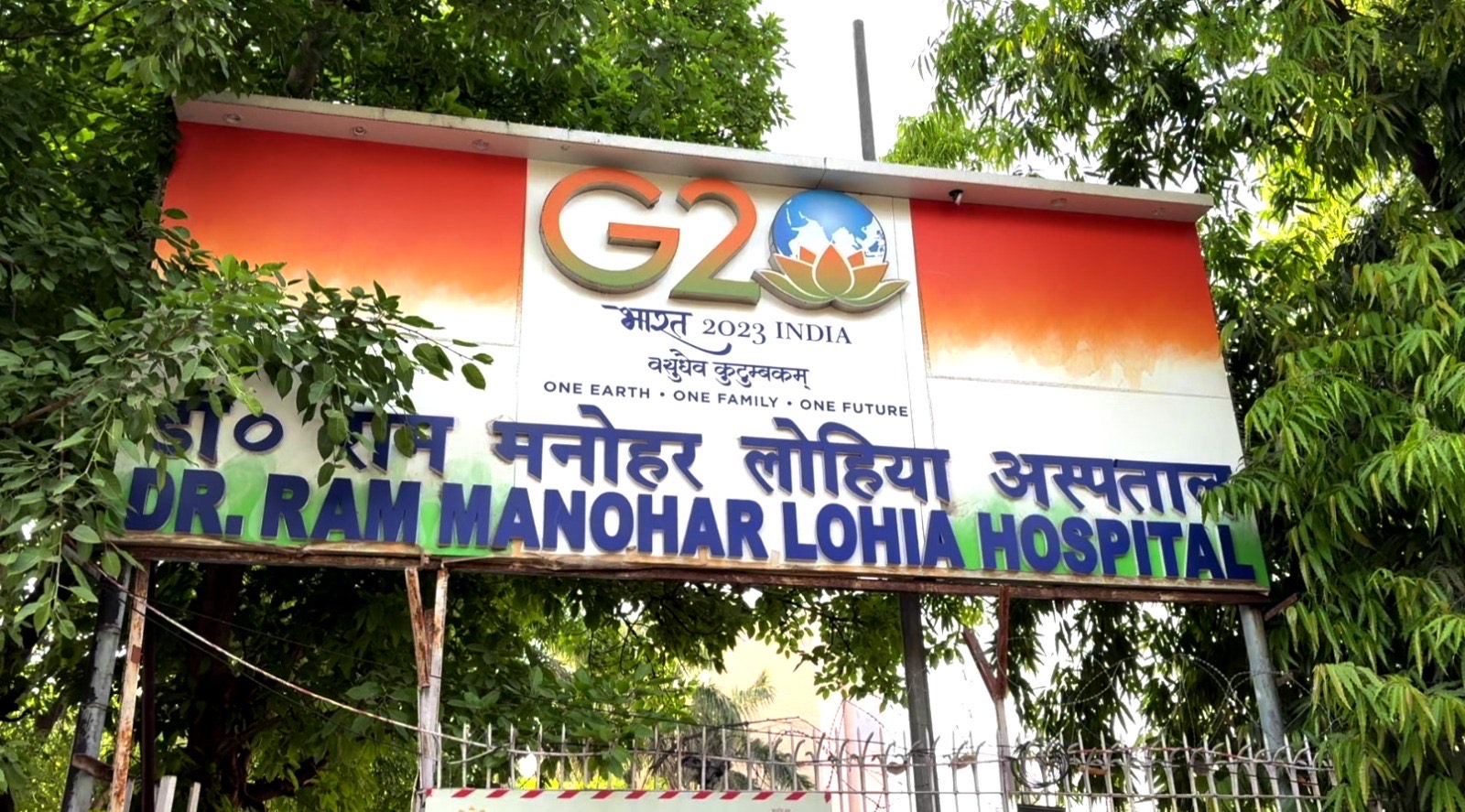In Dwarka Jungle the trees are buried alive behind the boundaries of tin sheets that are often used on construction sites. A hallmark of struggles between the ‘consumerist development,’ and ‘sustainable goals,’ the forest spread across 120 acres questions ‘new-classified,’ terms and definitions of being ‘identified,’ as a forest. Officially known as the ‘Bijwasan Rail Terminal Project Land,’ by the Railway Land Development Authority (RLDA) and the National Green Tribunal (NGT); this woodland is full of biodiversity, rare species, lush green trees and is threatened by the railway schemes since 2021.
Back on 19 February 2024, the National Green Tribunal declared that the trees on the Bijwasan Rail Terminal Project Land are not a ‘protected forest land,’ but still RLDA would require official permission from the forest department to chop them under the ‘Delhi Preservation Of Trees Act, 1994.’
Meanwhile, a forerunner of the ecological activism against the proposed Project, the ‘Save Dwarka Forest,’ has emerged as a ‘digital and on-ground campaign,’ by the ‘Fridays For Future,’ movement, chapter Delhi. Within a short period, it has received widespread national attention from youth, environment enthusiasts and green activists to save the forest.
‘We are also running a petition signing drive. Our Initiatives on social media platforms are getting huge support. From environment ambassadors like Diya Mirza to international organisations like ‘Green Peace,’ followed by hordes of hashtag activists and grassroots workers, we are resilient to inflame ecological consciousness,’ Prashant, a young activist at FFF, Delhi told FII.
On the ground level, the ‘Save The Forest,’ campaign is also organising nature walks, art activities and different creative events to engage the local people who are dangerously tempted by the ‘profit,’ they may attain from new development schemes of building mixed used edifices and station. Taking note of the swamping crowd in the capital, RLDA has marked the Bijwasan land as the ‘next significant hub,’ resulting in brutal construction plans, cutting of trees and uncountable damage to the green entity.
Between scientific definitions & governmental classifications of forest
‘Where is the Dwarka forest? I don’t know any such forest! There is no forest in Dwarka!‘ responded an officer from the concerned division of Delhi Forest Department when asked about the ongoing movement.
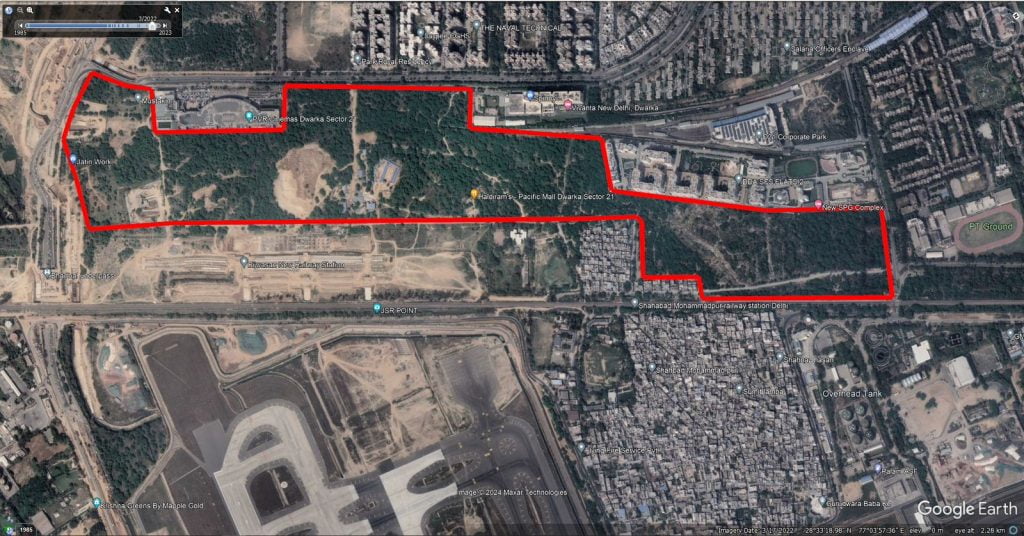
The Forest (Conservation) Amendment Act, passed in December 2023 has also helped in snatching its ‘authorised status,’ because of not recognising the ‘deemed forests,’ as a land to be concerned under FCA.
Anmol Ohri from Jammu Kashmir who is persistently endorsing the campaign on behalf of ‘Climate-Front India,’ an ally organisation said, ‘According to the scientific definition; bio-diversity and density are considered enough for a land to be acknowledged as jungle, but these parameters do not match our definitions. However, our constitution has been progressive and generous towards the environment.’
Activists have analysed that there is no clarity in different jurisdictive decisions regarding forests. The laws are being diluted to grow GDP and compete western countries. The people of nearby villages like Shahbad Mohammadpur and JJ colony (Dalit Basti) would be highly affected by the deforestation as it’s the only open space left nearby.
The ‘Fridays For Future, Delhi,’ which is a part of the international environmental justice movement initiated by young activist Greta Thunberg has documented more than 80 birds and 67 wildlife animals within the forest including Nilgai, rabbits, lizards, bullfrogs, blue throat, kingfisher and so on. Side by side, the ongoing campaign is actively documenting the loss of trees to keep the record on track and make a ground impact by reaching policy-makers.
Activists said that the developmental agenda has ‘overpowered’ viable goals and the western countries who set parameters of ‘GDP’ and ‘progress’ are now aware of environment while the developing countries like India and Africa are being flummoxed, fooled and played by the set-patterns.
Shedding light on the reasons behind the recent observation of NGT, the leading voice of FFF, Naveen Solanki said- ‘now the Railway may construct whatever it wants, there may be a role of private companies that have taken land on lease. RLDA did not present the accurate data and the National Green Tribunal has not conducted any fact-check.’
Under the banner of #SaveDwarkaForest activists are constantly raising their voices to attain ‘protected status,’ and to receive a ‘stay order,’ on the arbitrary construction works that have not stopped till now. They demand a ban on destructive activities to protect biodiversity, and wildlife and the eradication of RLDA plans that are assigning plots to private dealers on lease.
When 990 trees were buried alive in the Dwarka Forest
This 120-acre land was attained by the RLDA in 2008 and before that, it came under the terrains of Delhi Development Authority (DDA). The forests grew on the empty Railway land by itself. The activists at FFD, Delhi are also against the postmodern concepts of ‘green-washing,’ and ‘eco-friendly,’ they rather prefer more humanised terms like ‘co-existence,’ and observe ‘green-washing,’ as a means to attain a license for deforestation.
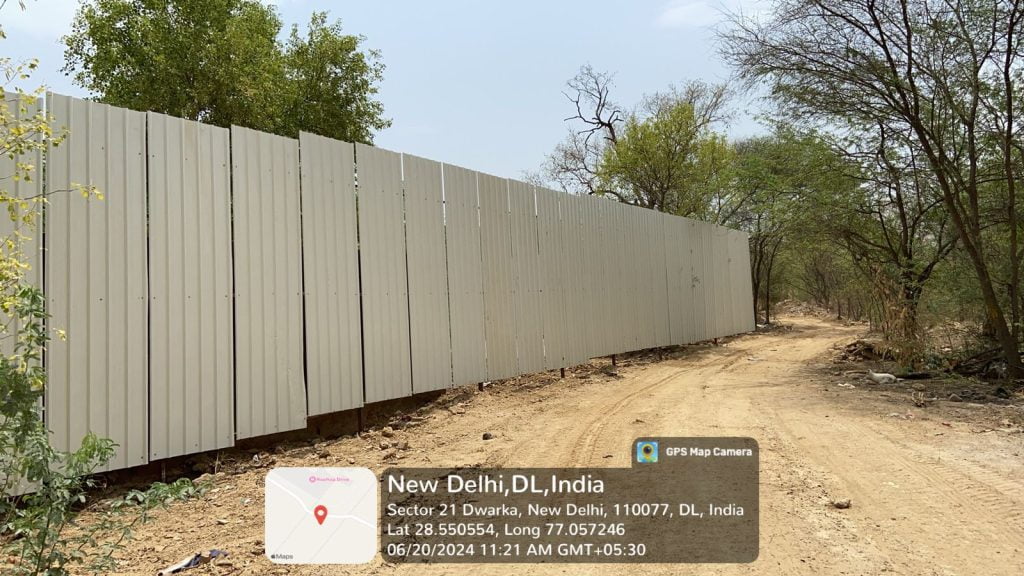
In 2021, Naveen Solanki from the nearby village of Shahbad Mohammadpur was the first to find the remains of dead trees in the forest area.
‘I used to take routine evening walks towards the forest area back in 2021 when I witnessed that some trees had been cut down. I checked the news and came to know about the RLDA project. It was the time I decided to fight for it. I approached several NGOs and some responded to me back,’ he told FII.
At first, Naveen along with some villagers attempted to stop the destruction inside the woods but it didn’t work. Later, on Naveen’s complaint, a survey was conducted by the forest department to investigate the matter. Back then, the Jungle was more thick, mostly dominated by Sheesham and Keekar trees. Because of having much more than 100 trees that are required to classify a patch as ‘deemed forest,’ the authorised status of the Dwarka forest was not in any miserable dilemma.
‘Through the survey, the Forest officer unveiled that around 990 trees have been damaged within 4 hectares. The railway workers did not cut the whole trees but buried them alive to hide the proof. Logs were found in the area. A little mountain of muddy soil still exists in the forest,’ told Naveen while showing Google images that indicated how the trees were being erased from a patch of land near Dwarka sector 21. Some trees were cut down from their roots but most were buried alive to prepare a ‘plain land,’ for the upcoming development projects.
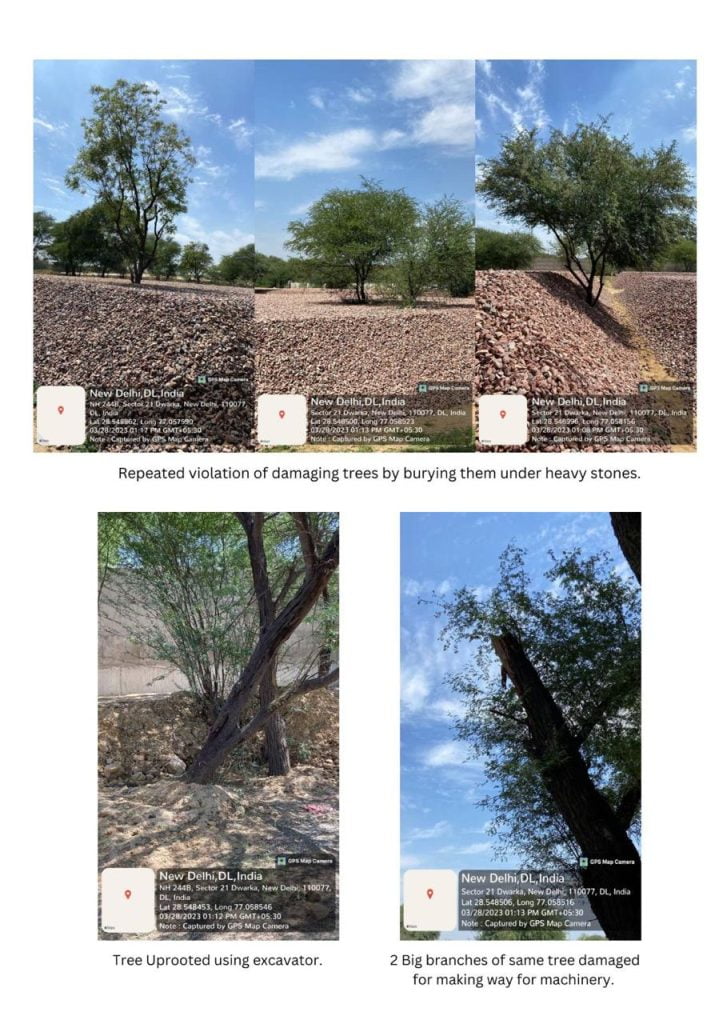
In July 2022 the forest department punished RLDA with a 5.9 crores fine. It was significant because a state body was pointing a department of central government for an ‘illegal activity.’
‘The Railway ministry, PMO and LG intervened in the case and the forest department was asked to pack up their bags and stop collecting evidence. Consequently, the previous officers were transferred and the new authorities don’t appear answerable,’ Naveen recalled in a state of despair.
The Railway terminal plan will hugely impact these villages, schools and local businesses. Even from an economic viewpoint, the station project, the already leased MU4, MU5, and MU6 plots in Dwarka would not be fruitful for sustainable goals, local economy, constitutional values, cultural filaments and democratic principles.
There is adequate space in nearby regions where the Railway can find better alternatives, but focusing on the ‘land,’ rather than ‘purpose,’ is a tendency constantly observed in such battles of ‘Jal, Jangal, Zameen.’
The significance of saving Dwarka Forest and blistering ecological concerns
The national capital, Delhi has constantly been flagged by the UN and WHO for its environmental hazards. Particularly, the scorching temperature during the Summer of May 2024 inflamed widespread concerns. Apart from air pollution and water pollution, ecologists are tracing the systematic devastation of natural entities that is a threat to life expectancy in jam-packed cities like Delhi.
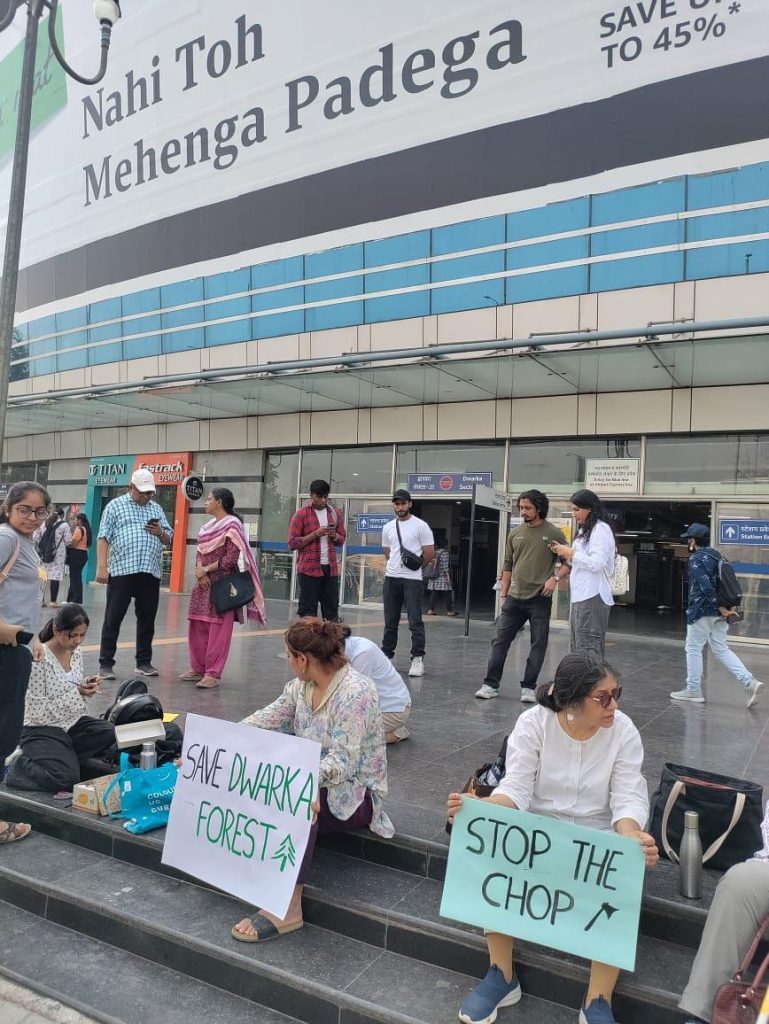
This urban forest is home to numerous wildlife creatures. After the green covering was eradicated from the banks of the seasonal Sahibi River, it became a prominent shelter for them. For the metropolitan population of Delhi that lives at higher risks of earthquakes and mounting temperatures, the green lush is a gush of relief.
‘These officers in the air-conditioned chambers of Delhi must think about the future of their children. They must look at the history and future. Where will they go if civilisation falls?’ said Anmol.
The incidents of illegal ‘soil-dumping,’ ‘tree-burials,’ and deforestation still keep happening in the area. When bulldozers bury trees, they also affect the living trees. The construction work is going on and the contractors are rapidly encircling the jungle with boundaries that are harmful to birds and wildlife animals.
Addressing the protection of Jungles on a broader scale, Anmol said, ‘The recent amendment in the forest conservation act states that the areas within 100 Km. of the national border can be used for defence projects. But they don’t know that environmental security is crucial to ensure national security. When the dam broke in Sikkim in 2023, it was the Indian Army that faced tyranny.’
‘Save Dwarka Forest,’ campaign is also being perceived as an ‘anti-fascist,’ movement and an ‘intergenerational battle.’ Those contributing to this green activism stream are mostly youngsters and teenagers because the future belongs to them and they demand security, resources and a good environment to survive.
The ongoing campaign demands ‘accountability, acceptance and action,’ to stir up the waves of change. This lability is expected on the policy level as well as politically. It summonses the decision-makers to redefine the definitions of forests and to come up with humanitarian, constitutional and ecological approaches.
About the author(s)
Mariyam (she/her) has a thirst for journalistic and creative stories that consist of feminist, humanitarian, contemporary or artsy themes. She hails from a Political Science, English Literature academic background and an Urdu-Hindi crux.
For her, words are a visionary sovereignty to stand on and find the meaning of being while journalism is the only place where truth comes with utmost clarity, facts and data. When not weaving pointy narratives or poetic expressions, she loves mingling with cats or delving into photography, cinema, music, daydreaming and stargazing.
